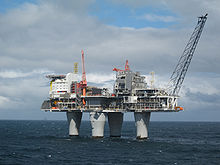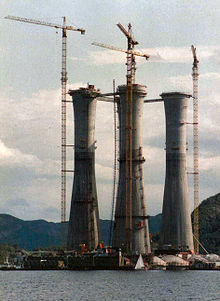From Wikipedia, the free encyclopedia

A view from the South East of Troll A Platform.
The Troll A platform is a Condeepgravity-based structure offshore natural gas platform in the Troll gas field off the west coast of Norway. Built from reinforced concrete, as of 2014, it was the tallest structure that has ever been moved to another position, relative to the surface of the Earth, and is among the largest and most complex engineering projects in history.[1] The platform was a televised sensation when it was towed into the North Sea in 1995, where it is now operated by Equinor. It is also the heaviest object moved and the object with the second highest displacement at 1.2 million tons[2](the object with the highest displacement is the Gullfaks C, which had a displacement approaching 1.5 million tons[3] in comparison with Troll A's 1.2 million). Troll A was towed from the afternoon 10 May 1995 until the platform was in place 17 May 1995. It was lowered to the seabed in 303 meters of water, and had penetrated 36 meters into the soil by 19 May 1995[citation needed]. It was self-supporting with no further mooring required[citation needed].

Continuous
slip formedgravity-based structure supports under construction in a Norwegian
fjord. The tower cranes delivered concrete to the support cylinders during the continuous pour of concrete to create seamless walls.
The Troll A platform has an overall height of 472 metres (1,549 ft), weighs 683,600 tons (1.2 million tons with ballast)[4] and has the distinction of being the tallest structure ever moved by mankind. The platform stands on four legs extending down to the sea floor 303 meters (994 feet) below the surface of the sea, and the leg containing the import and export risers has an elevator that takes over nine minutes to travel from the platform above the waves to the sea floor.[5]